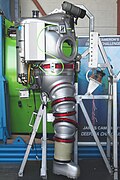
The Newtsuit is an atmospheric diving suit designed and originally built by Phil Nuytten. [1]
Contents
The suit is used for work on ocean drilling rigs, pipelines, salvage jobs, and photographic surveys, and is standard equipment in many of the world's navies. [2] [ clarification needed ]
This aluminum hard suit has fully articulated, [3] rotary joints in the arms and legs, giving the pilot a substantial range of mobility. [4] These joints operate freely at high pressures. At the time the suit was constructed, it was the first of its kind in this regard. The pilot can control objects and handle tools with manipulator jaws at the ends of the arms. Although the suit is certified to 300 metres (980 ft), it has been tested to 900 metres (3,000 ft). [5]
The suit can be operated untethered, with a thruster pack that can be fitted to the suit. This allows mobility in mid-water. [1] The Newtsuit navigates with foot controls. The left foot provides vertical control, with the right foot providing lateral control. [3] Other equipment that can be attached includes twin video cameras, colour imaging sonar, and an atmospheric monitoring system (AMS) that transmits information to the surface, such as CO2, HPO (high pressure oxygen), O2%, depth, temperature, and cabin pressure. [3]
Communication is achieved through digital voice/data transmission via water and umbilical cable. [3]

